Author: Peter Meincke, Ottawa.
Note: This paper contains many examples of new technologies that are either being applied or could be applied in small islands. The references are not to articles in refereed journals but, are quotes from articles on the internet. The link for each quote is given.
Helpful comments from a number of colleagues are gratefully acknowledged.
Introduction
In order to develop sustainability and cope with climate change, small islands could do the following:
- Eliminate or drastically reduce CO2 emissions
- Reduce their reliance on linear economies in which resources are converted into products which are then thrown away
- Increase the use of circular economies in which materials are recycled
- Increase the use of local resources to meet local needs
- Recognize that waste is resource in the wrong place
- Provide incentives and opportunities for young people so they do not leave their small islands.
- Increase use of information technologies to share good practices and learn about new developments.
- Develop Adaption strategies in the event sea levels rise and/or the severity of storms and waves increase.

Since the contribution to climate change and sea level rise by small islands is much smaller than the rest of the world, it is essential that those countries which are the largest emitters of GHG do whatever they can to reduce that emission and those countries which are rapidly developing like China and India meet their growing need for energy as well as replace current GHG emitters through clean technologies.
This paper will explore how many recent developments in technology could help small islands and remote communities achieve many if not all of these goals. These developments include:
- Dramatic reduction in cost of traditional photovoltaic cells as well as innovations.
- Greatly improved energy storage technologies.
- Dramatic reductions in the cost of wind power
- Water including wave tidal
- Geothermal
- 3D printing
- Food production
- Transportation such as electric vehicles, drones, solar planes
- Rapidly improving communications and information technologies
Reduction of the cost of photovoltaic cells
“The cost of solar power has declined dramatically over the past few decades, from $40 per watt in 1977 to $0.74 per watt in 2013. This trend is expected to accelerate as improvements in efficiency and new technologies come online. This is good news for citizens of developed countries who want to make the switch to a cleaner and increasingly cheaper energy source. The shift to solar may be most dramatic for those living in developing countries.”
Costs as low as at 2.99 US cents per kilowatt hour (kWh) have been quoted.
Costs tumble as Dubai’s Mohammed bin Rashid Al Maktoum Solar Park sets the mark
Solar and wind costs predicted to plunge by 60% by 2025
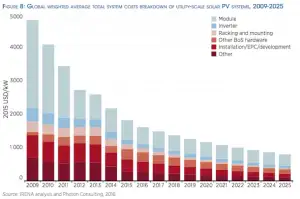
The Rocky Mountain Institute and the Carbon War Room have published a casebook of profiles of renewable microgrids in 10 small islands and remote communities around the globe. This excellent document is available at:
RENEWABLE MICROGRIDS: PROFILES FROM ISLANDS AND REMOTE COMMUNITIES ACROSS THE GLOBE
Other examples are cited below.
“A large-scale solar project that would slash the need for diesel imports for power generation in the Marshall Islands is being considered by two big donor agencies, said the new President of the country, Dr. Hilda Heine.
The planned solarization of Jaluit, Wotje and Rongrong islands will dramatically change their energy status from 100 percent reliance on diesel-powered electricity to a 90 percent solar-10 percent diesel mix. This is projected to save the government $1 million in annual subsidy. Ebeye Island, which has a 20 percent of the Marshall Islands population of 55,000, is to convert 35 percent of its grid power to solar, with a 12-acre array of solar panels being installed on a neighboring island. This will slash the Ebeye utility firm’s fuel bill by over $1 million a year, a cost now subsidized by the government.”
Big solar project aims to save Marshall Islands millions of dollars
Ameland Island the Netherlands
“Recently, the largest solar park of the Netherlands was opened on Ameland. This 10-hectare solar park, with an output of 6 MW, provides in the annual electricity demand of the Amelander households. It looks as if this means that they are well on their way, but the heat demand of the households is 5 times higher than the electricity demand. This would require an extra 5 similar solar parks, which would only be enough for just the households on the island. In addition, most sustainable electricity is generated in the summer period, while the need for energy for heating is highest in the winter months. For that reason, Ameland is now researching the possibility of producing green gas in the sewage water purification plant through high-pressure fermentation. Biomass is probably easier to store than the electricity generated by solar parks.”
“The parties to the Duurzaam Ameland project (the Municipality of Ameland, Philips, NAM, Eneco and gasTerra) are currently researching opportunities for the expansion of solar parks, hybrid heat pumps, hydrogen production, electricity storage, electric transportation, LED street lighting and a smart grid on the island. The goal is to ensure that in 2020, Ameland will be years ahead (approx. 15-20 years) in the energy transition process, and that they gain the required knowledge of and experience with the process. Ameland should be seen as a testing ground for energy transition, but the collaboration with the people of Ameland is paramount.”
If the Dutch government gives Ameland the status of testing ground, experience with new rules on energy can be gained, enabling the transition to a reliable, affordable and CO2-neutral energy supply.
Ameland, towards CO2-neutral energy
Kangaroo Island Luxury Eco-Villas Are 100% Solar
New Kangaroo Island Luxury Eco-Villas Are 100% Solar Powered
Kangaroo Island Airport Visible Solar Project
Dunstan proposed a 8MW wind turbines, 4MW centralised solar PV, and 4MW rooftop PV, with 3MW battery storage, most of it co-located with solar PV. This would be combined with energy efficiency measures and a small diesel plant running at just 3 per cent load factor.
It concluded that the indicative total cost would be around $50 million, the same as the cable but invested on the island. There would be additional operating expenditure of $1.2 million, and annual bill savings to Kangaroo Island customers of around $3 million, or 30 per cent.
Can Kangaroo Island be powered by 100% renewable energy?
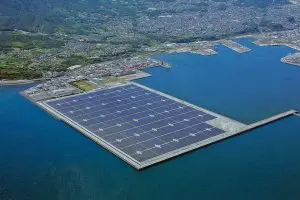 As Japan seeks to end reliance on nuclear power, one of the answers is floating ‘solar islands’, writes Jon Major. A 70MW solar island opened last year, and two additional plants have just been announced.
As Japan seeks to end reliance on nuclear power, one of the answers is floating ‘solar islands’, writes Jon Major. A 70MW solar island opened last year, and two additional plants have just been announced.
Japan: ‘solar islands’ replace nuclear power
“The just ended Caribbean Energy Security Summit in Washington gave a commitment to support the Caribbean’s transformation of the energy systems.
In a joint statement the Summit pledged to pursue, among other things, comprehensive, planning-based and research-driven approaches to energy transition; the promotion and development of affordable no-or-lower carbon electricity generation through wind, solar, geothermal power, hydropower, bioenergy, ocean energy, energy recovery from waste, and other clean energies; and promotion of energy efficiency measures while also recognising that alternative fuels, such as natural gas, can play a useful bridging role.
The institutions and member states which participated in the 3-4 May Summit, hosted by the US Vice-President Joe Biden were: the Governments of Antigua and Barbuda, Aruba, Bahamas, Barbados, Belize, Canada, Colombia, Curacao, Dominica, Dominican Republic, France, Germany, Grenada, Guyana, Haiti, Jamaica, Mexico, New Zealand, Spain, St. Kitts and Nevis, St. Lucia, St. Vincent and the Grenadines, Suriname, Trinidad and Tobago, United Kingdom, United States, together with the Caribbean Community (CARICOM) Secretariat, Caribbean Development Bank, European Union, Inter-American Development Bank Group, International Renewable Energy Agency, Organization of American States, and the World Bank Group.”
Caribbean energy sector to get transformation support
Innovation
“Thanks to inexpensive printed solar cells, 1.3 billion people currently without electricity may be able to plug in for the first time.
Paper-thin solar cells require only an industrial printer to manufacture and are inexpensive to produce. Unlike traditional panels, the printed solar cells are flexible, which eases their transportation to rural locations. Printed solar cells have developed rapidly, rising from 3% efficiency to 20 percent in just a few years. “
Paper-thin printed solar cells could provide power for 1.3 billion people
“U.K company Renovagen is looking to harness the power of the sun – wherever it shines – with “rollable” solar arrays that can be rapidly deployed in a variety of locations.“
Portable power with solar panels you can roll up
Scientists have developed solar cells 100 times thinner than a human hair
Wind
Prince Edward Island
The legacy of the Atlantic Wind Test site started in PEI in the 70’s continues with three sites producing 30% of the island’s electricity.
‘El Hierro, the smallest and most westerly of the Canary Islands, has become the first isolated territory in the world to meet all its energy needs using renewables. For four hours from 12 noon on Sunday August 9, the Gorona del Viento wind-hydro power station generated all the electricity for the tiny island of 10,000 inhabitants using clean energy – the culmination of a project that began 30 years ago.
The Gorona del Viento wind-hydro power station has been hooked up to five wind-powered generators that together are able to produce the 35 GW/h the island requires. In the coming decades the system will save El Hierro around €80 million that would have been spent on 6,000 tons of diesel each year, as well as reducing carbon emissions by around 20,000 tons annually.
The project, which has cost €82 million, has been hailed as a major achievement around the world. It represents the first time that wind and hydro power have been combined.” (11 MW)”
El Hierro becomes first isolated territory powered 100% by renewables
Galapagos
“The project’s three 51-metre-tall wind turbines and two sets of solar panels have supplied, on average, 30% of the electricity consumed on San Cristóbal, the archipelago’s second-largest island in size and population, since it went into operation in October 2007.
During that time, it has displaced 8.7 million litres (2.3 million gallons) of diesel fuel and avoided 21,000 tonnes of carbon dioxide emissions, the GSEP report states. The achievements have led to awards from Power Engineering Magazine, World Energy Forum, and Energy Globe.”
Read more at: Wind turbines on Galapagos replace millions of liters of diesel since 2007
“Ecuador, with the help of the United Nations, quickly enlisted the help of the Global Sustainable Electricity Partnership, made up of 11 of the world’s largest electricity companies, to reduce the risk of another oil spill at this UNESCO World Heritage Site. Between 2007 and 2015, three 157-foot wind turbines have supplied, on average, 30 percent of the electricity consumed on San Cristóbal, replacing 2.3 million gallons of diesel fuel and avoiding 21,000 tons of carbon dioxide emissions.”
Wind turbines are powering nature’s paradise (and haven’t killed a single bird)
Water waves and tidal
Tidal Power for the Orkneys
- “The world’s most powerful tidal energy turbine has been assembled at Harland and Wolff shipyard in Belfast.
- Each of the its twin rotor arms produces 1 megawatt of energy – enough to power thousands of homes when connected to the electricity grid.
- After trials in the lough, the turbine will be used off the Orkney Islands.
- The 75-metre long structure has taken a year to put together.
- It will float on the water with the rotors dropped below the surface.”
Tidal turbine: World’s most powerful generator built in Belfast
Garden Island Australia
“The project by Perth-based Carnegie Wave Energy will provide renewable electricity for Australia’s largest naval base, HMAS Stirling, on Garden Island.
The same system is also used to run a small desalination plant, which will be used to supply up to one-third of the base’s fresh water needs.
Carnegie has placed buoys beneath the ocean surface off Garden Island and when waves move the buoys, it creates hydraulic pressure that is delivered to a plant onshore to be converted to power for the base.”
WA wave energy project turned on to power naval base at Garden Island
“A beautiful stretch of coastline in Swansea, southern Wales will soon be home to an energy-generating lagoon. Work is expected to begin in early 2017 on the 1.5 billion euros project to build a 9.5 kilometer sea wall.
16 bi-directional turbines sat on the sea bed will be used to help monitors measure the difference in water level between the sea and the lagoon.
Initially, the level in the lagoon will be low and as the tide comes up, water starts flowing into the lagoon through the turbines. The turbines power the generators which deliver electricity into the grid. And then the opposite way when the tide comes down. “
Swansea’s energy-generating lagoon primed for power
World’s first ever tidal lagoon power plant making waves in the UK
Storage
Developments in batteries and capacitors can be found in these links.
Tesla’s Elon Musk confirms Powerwall 2.0 is on the way

5000 farads
The Battery Miracle Will Transform Both Transportation And Power Generation
New 3D printed graphene super batteries by Swinburne researchers will last a lifetime
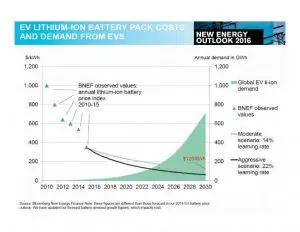
“The Crescent Dunes Solar Energy Plant located about 225 miles northwest of Las Vegas is capable of generating 110 megawatts of power – that’s enough for 75,000 homes. The solar plant uses more than 10,000 mirrored heliostats spread across 1,600 acres to focus sunlight on a 640-foot tall central tower filled with molten salt. That salt is heated by the sunlight to nearly 1,000 degrees Fahrenheit; this stored heat is then used to convert water to steam and drive electricity-producing generators.”
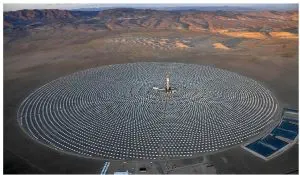
Revolutionary new solar power plant generates energy all day and all night
Adaptation
“Since Five islands have disappeared in the Pacific’s Solomon Islands due to rising sea levels and coastal erosion, according to an Australian study that scientists said Saturday could provide valuable insights for future research. And A further six reef islands have been severely eroded in the remote area of the Solomons, the study said, with one experiencing some 10 houses being swept into the sea between 2011 and 2014 it is essential they find the best ways to adapt to climate change impacts such as sea level rise, increased severity of storms and fluctuations in weather.
“At least 11 islands across the northern Solomon Islands have either totally disappeared over recent decades or are currently experiencing severe erosion,” the study published in Environmental Research Letters said.
“Shoreline recession at two sites has destroyed villages that have existed since at least 1935, leading to community relocations.”
Sea-level rise claims five islands in Solomons: study
‘Sea levels are rising so fast that the tiny Pacific state of Kiribati is seriously considering moving its 100,000 people on to artificial islands. In a speech to the 16-nation Pacific Islands Forum this week, President Anote Tong said radical action may be needed and that he had been looking at a $2bn plan that involved “structures resembling oil rigs”:
“The last time I saw the models, I was like ‘wow it’s like science fiction, almost like something in space. So modern, I don’t know if our people could live on it. But what would you do for your grandchildren? If you’re faced with the option of being submerged, with your family, would you jump on an oil rig like that? And [I] think the answer is ‘yes’. We are running out of options, so we are considering all of them.”
“Kiribati is not alone. Tuvalu, Tonga, the Maldives, the Cook and the Solomon Islands are all losing the battle against the rising seas and are finding it tough to pay for sea defences. Kiribati faces an immediate bill of over $900m just to protect its infrastructure.”
“Kiribati could also take a lesson from the Maldives, where the rubbish of the capital city Male and the hundreds of tourist islands, is sent to the artificial island of Thilafushi. It’s growing about one square metre per day.”
“Kiribati could emulate Spiral Island in Mexico. This was constructed by British artist Richard “Rishi” Sowa on a base of 250,000 plastic bottles. The island was destroyed by Hurricane Emily in 2005 but is being rebuilt. With millions of tonnes of rubbish already floating in the Pacific, and plans to collect it, Kiribati could solve two problems in one go.”
A Remote Pacific Nation, Threatened by Rising Seas
“In response, Kiribati (pronounced KEE-ree-bas in the local language) has essentially been drawing up plans for its demise. The government has promoted “migration with dignity,” urging residents to consider moving abroad with employable skills. It bought nearly 6,000 acres in Fiji, an island nation more than 1,000 miles away, as a potential refuge. Fiji’s higher elevation and more stable shoreline make it less vulnerable.”
Anote Tong, a former president who pushed through the Fiji purchase, said it was also intended as a cry for attention from the world. “The issue of climate change is real, serious, and we’d like to do something about it if they’re going to take their time about it,” he said in a recent interview.
Geothermal
The innovative use of geothermal power by islands like Iceland and Hawaii is well known and need only be mentioned briefly in this paper.
The geothermal sector in Turkey, which is developing very dynamically, is very likely to reach the objective of 1,000 megawatts (MW) capacity well before its target of 2023, said Natalia Khanjenkova, managing director for Turkey and Central Asia at the European Bank of Reconstruction and Development (EBRD) on Tuesday.
Speaking exclusively to Anadolu Agency, Khanjenkova said Turkey has big potential for geothermal energy.
“I understand the estimates are between 2,000 – 4,500 MW which are significant resources. This, combined with a strong regulatory framework and very good job done by the government, create the framework that helps investors in the geothermal sector. Another critical factor is the very vibrant private sector that is eager to invest,” Khanjenkova said.
Turkey to reach geothermal energy target by 2018
Food production
“Just as climate change threatens to affect the way we live in the future, our choices can also contribute to global warming, including what we decide to eat on a daily basis. So scientists are developing a new environmentally friendly rice variety that’s now been recognised as one of the most important breakthroughs of the year.
The genetically modified SUSIBA2 rice gives off virtually no greenhouse gas emissions while growing, and has been developed by a team of scientists spread across three continents.”
This new climate-friendly rice has been named one of 2015’s top scientific developments
Meet the father-son farmer duo revolutionizing Ontario’s shrimp business
FarmedHere, a 90,000-square-foot space in Bedford Park that opened in 2013, is not only the first organically-certified indoor vertical aquaponic farm in Illinois, it’s also the largest indoor farm in North America.
FarmedHere’s two-story, windowless farming facility currently sits on the site of a formerly abandoned warehouse in the outskirts of Chicago.
A variety of plants grow on racks that are stacked on top of each other in a vertical farming system, as well as an aquaponics system, which combines tilapia (and the fish’s waste) and plants (which filter the waste) to grow food. (Just like the Ark in PEI in the 1970’s)
The company says that total growing time is about 30 days, which is half the time of traditional farms.
“Our vertical growing technology and local distribution methods reduce energy use, travel time and costs tremendously, making this model one of the most sustainable ways to guarantee access to fresh, healthy produce in city centers, in any season,” the company, which launched in 2010, advertises on its website.
FarmedHere Wants To Bring A Vertical Farm To Your City
Inside the Nation’s Largest Organic Vertical Farm
Chicago home to 820 Urban Farms
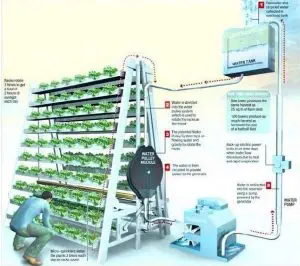
Singapore
“This soil based vertical farm produces one ton of vegetables every other day and is five to ten times more productive than a regular farm…..This vertical farming system, called “A-Go-Gro” technology, grows vegetables in A-shaped towers, each of six meters tall. These modular A-frames are quick to install and easy to maintain. Each tower consists of 22 to 26 tiers of growing troughs, which are rotated around the aluminium tower frame at a rate of 1mm per second to ensure uniform distribution of sunlight, good air flow and irrigation for all the plants. “
Vertical Farming: Singapore’s Solution to Feed the Local Urban Population
Transportation

The rapid growth of electric cars worldwide, in 4 charts
“But what you may not realize is that major EV makers — BMW, GM, Nissan, Toyota — are now exploring how much value their EV battery has for use in the electricity storage market after that battery can no longer meet the strict requirements for powering its car. This potential second life for EV batteries is a clean energy game changer for two reasons:
- These used EV batteries hold the promise of much cheaper electricity storage for renewables than is available today.
- If used EV batteries have value, then EV makers can charge less for their cars, making them even more affordable
Together, these two factors make EVs even more disruptive than most people realize, particularly for enabling deep and rapid penetration of renewables in the 2020s.
Why Used Electric Car Batteries Could Be Crucial To A Clean Energy Future
Lithium–air batteries, also known as breathing batteries, harness the energy produced when lithium metal reacts with oxygen from the air. Because they do not have to carry around one of their main ingredients (oxygen), and because lithium metal has a low density, they can — in theory — store as much energy per kilogram as a petrol engine. That means that the batteries might stuff in energy ten times more densely than the best battery packs in current electric cars, which researchers hope might let vehicles travel as far as 800 kilometers before they need recharging.”
“It’s been estimated that shipping accounts for 3 to 4 percent of human-caused carbon emissions. More than 47,000 big ships handle the bulk of this cargo, most of which (by weight) is made up of crude oil, iron ore, coal and other building blocks of the modern world. About 6,100 container ships carry the consumer goods we’re more likely to encounter and purchase — the televisions and socks and frying pans of day-to-day life.
Aside from being the cheapest mode, it’s also the most carbon-efficient method of shipping: A big ship will emit about 10 grams (0.4 ounces) of carbon dioxide to transport 1 metric ton of cargo 1 kilometer (2 tons of cargo 1 mile). That’s roughly half as much as a train, one-fifth as much as a truck and nearly a fiftieth of what an airplane would emit to accomplish the same task.”
The Conundrum of Transporting Our Goods
“Starting next month, doctors and nurses in far-flung areas of Rwanda will be able to order blood and emergency medicine via a text message.
Drones, part of a new breed designed to save lives, will fly to a clinic using GPS coordinates but instead of landing, it will drop a small package by parachute.
Zipline, the company behind the project, says the aircraft will be capable of making up to 150 deliveries to 21 facilities in the African country, which has a scattered population.
This story from Al Jazeera was supplied to AllAfrica under an agreement with the African Media Agency.”
Rwanda: Drones to Deliver Medical Supplies in Rwanda
“Google is testing solar-powered drones at Spaceport America in New Mexico to explore ways to deliver high-speed internet from the air, the Guardian has learned.
In a secretive project codenamed SkyBender, the technology giant built several prototype transceivers at the isolated spaceport last summer, and is testing them with multiple drones, according to documents obtained under public records laws.”
Project Skybender: Google’s secretive 5G internet drone tests revealed
3D printing
3D printing makes it possible for small islands to make use of local resources to meet local needs while taking advantage of the latest innovations through trade in information. The internet gives them access to purchase or sell programs to run the 3D printers to manufacture to product to meet local demand. Here are some examples of what could be done.
“Andreas Haeuser has impressed with his 3D printed inventions, which include a wind turbine and solar powered Stirling engine, before. The German engineer’s latest design, the Ardumower, is an automated, robotic lawn mower that zips around the yard and cuts grass by itself, sort of like a Roomba for the lawn. It’s compact, sturdy, and looks to be remarkably effective. All you need to build your own is a 3D printer, some basic electronics, and Haeuser’s detailed instruction manual, which can be downloaded from his website, along with the necessary STL files, for $12.95.”

3D Printed Robotic Lawnmower is Like a Roomba for Your Lawn
Soon-to-Be-Released Aether 1 3D Printer Can Do Absolutely Everything
“So as wind turbines seem to be getting taller and bigger for maximum efficiency, what can they do for us on the micro level? This was answered recently at the 2015 Paris Climate Conference (COP21), as several companies collaborating on this innovation were on hand to show off their designs, which are not just exponentially smaller in size–but they are also 3D printed.
Created by Orange Silicon Valley, the Silicon Valley-based innovation center of global telecommunications company Orange; Lumenir, Inc., a Silicon Valley energy-as-service company offering low-cost, renewable energy solutions in developing countries; and Omni3D, a Poland-based 3D printer manufacturer, the micro turbines are meant to offer greater accessibility to the technology for the masses.
Obviously, hauling in a wind turbine that stands 80 meters tall is quite an endeavor, not to mention substantial expense–but what about one that is a fraction of that size, and is easy to transport, install, and make? Offering the 3D printing self-sustainability factor all around, these wind turbines are meant for urban areas, as well as those that are remote, offering energy to those who are completely without.”
3D Printed Micro Turbines to Bring Electricity to Urban Areas & Help the Energy Impoverished
“That is quite necessary, as reports reveal that the 3D printed wind turbine features blades half a meter tall, made from ABS with an internal honeycomb structure to save materials. The final blade structures consists of 93% air – much more efficient and affordable than, say, milling, parts. ‘Industrial 3D printing creates an opportunity for milling workshops to fabricate parts cheaper, faster and easier. Fabricating large ABS parts is a task that can be accomplished by only few printers in the world and we’re happy to be a part of this project,’ explained Omni3D’s Konrad Sierzputowski.”
Cheap, efficient 3D printed micro turbines could bring energy to remote locations
Another by Andreas Haeuser
What about materials to feed the 3D printers. Here are some promising examples of converting waste into resource.
“So three engineering physics students at the University of British Columbia in Canada have invented the ProtoCycler, a device that can grind up all kinds of waste plastic into a beautiful clean spool of plastic filament that can be used in a 3D printer. We’re talking anything – plastic bottles, 3D-printing cut-offs, takeaway food containers. If your kids leave their LEGOs out one too many times for you to tread on with your bare feet… throw them in too. It works just like a juicer.”
Ref This new device recycles plastic bottles into 3D-printing material
Emerging Objects has taken these tires and put them through a cryogenic process where they are frozen and then turned into a powder which was then used to 3D print objects. The hope is that perhaps this 3D printed rubber could be used as a future building material. Rubber is a very forgiving material, so the potential seems to be there for future architecture
The paper, which is pulverized, is then turned into a material that is compatible with 3D printing. The hope here is to use this 3D printed paper as insulation, sound attenuation, packaging, etc. Just imagine if we no longer had to waste paper, and instead it could be reused within many industries
Recycled Beer and Coffee Can Now Be Used for 3D Printing by Virginia Chamlee
How might 3D printing affect the rest of the world?
Magnus Rentzhog Senior Advisor, Swedish National Board of Trade writes
“3D printing, blockchain technology, and decentralised production. There is a new world order out there and it is changing the trade world as we know it.
3D printing (3DP) is a technology that builds physical objects directly from 3D computer-aided design (CAD) data and adds different materials, layer-by-layer, with the help of a 3D printer. In a new report, “Trade Regulation in a 3D world”, we at the National Board of Trade (Kommerskollegium) examined, among other things, how 3DP changes what is being traded, how it is being traded, and by whom.”
3D printing and blockchain could change world trade as we know it
A recent Epoch article by Matthew Little explores the threat to globalization by the middle class backlash.
Middle-class backlash threatens globalization
Could 3D printing help?
Some intriguing new energy technologies
“Researchers at the University of Illinois at Chicago have engineered a potentially game-changing solar cell that cheaply and efficiently converts atmospheric carbon dioxide directly into usable hydrocarbon fuel, using only sunlight for energy”
Breakthrough solar cell captures carbon dioxide and sunlight, produces burnable fuel
The Suncell by brilliant Light and power uses a catalyst to cause hydrogen atoms of water molecules to transition to the lower-energy Hydrino® states by allowing their electrons to fall to smaller radii around the nucleus. This results in a release of energy, that is intermediate between chemical and nuclear energies, and a nonpolluting product. Photovoltaic panels then convert the intense light to electricity.
A video of a demonstration and a convincing slide presentation are available through the website:
Low Energy Nuclear Reaction (LENR) has created a lot of excitement as well as enormous skepticism.
Rossi has just completed a year long test and the rumoured results are positive.
Even though the technology is not as advanced as solar power, it is still worth including because if it does prove to be real, it has enormous potential to meet the energy needs of small islands.
A team of researchers in the UK is turning urine into electricity. By By David K Gibson, 12 July 2016
“The technology is so promising that it has garnered the support of the Bill and Melinda Gates Foundation, and is currently being deployed through Oxfam to bring pee power to refugees in the developing world”
Your next car could run on pee
CONCLUSIONS
Small islands have the opportunity not only to find a path to a sustainable future but also show the rest of the world possible paths to a sustainable future.
Much has to be done to make this possible:
Shifting from trade in materials, goods and services to trade in information and know-how over the internet and using 3D printing will make it possible for small islands to make more use of local resources to meet local needs.
But trade agreements will have to be modified so they can better deal with trade in information and know-how. The World Trade Organization (WTO) will have to change its policies to so it does not punish India for encouraging its own solar energy industry.
The extensive tourism on small islands offers an ideal opportunity not only to reduce GHG emissions but also to educate visitors about the potential of new technologies. One tourist resort is powered entirely by the sun. The diesel powered desalination system on Half Moon Cay could easily be replaced reducing the need for diesel fuel and providing an excellent example for the many cruise tourists who stop there. Edward Manning has been providing excellent advice on sustainable tourism for years and reports on some of his work can be found at Tourisk Inc
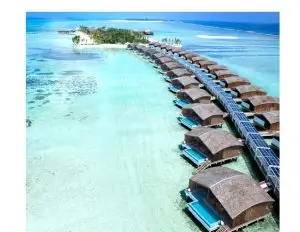
Climate change and sustainable development have been plagued by misinformation leading to confusion and inaction. It is essential that everyone ranging from decision makers in government and the private sector to the general public who can make a difference by their votes and purchasing power have ready access to reliable information and the education to understand that information.
An important initiative is a Climate Feedback site which allows scientists to correct media errors.
Climate Feedback site allows scientists to correct media errors
Small Islands have very limited resources to asses which technologies are best for them, arrange for financing, acquire and install the technologies.
It is essential to develop a highly sophisticated virtual infrastructure using the many recent developments in internet based technology to provide the latest information about the new technologies, rules and regulations for their installation and use, and share best practices.
Early attempts to develop virtual infrastructures such as the Small Islands Information network developed by Sharon Ross and the author at UPEI have been surpassed by SIDSNET and GIN but much more needs to be done.
Development assistance has to be modified to encourage the adoption of these new technologies. It is encouraging to see that the Commonwealth Secretariat has recommended that country loans be reduced by the amount the country spends on reducing GHG emissions.
Developing Nations to Get ‘Tailor-Made’ Climate Advice
“For developing countries seeking to turn their national climate action plans into reality, help will soon be at hand in the form of a support service announced by the German government and the U.S.-based World Resources Institute this week.
The global partnership, open to all countries, aims to provide developing states with the expertise they need to transform their targets to reduce planet-warming emissions into concrete strategies and measures.
Close to 190 countries have submitted plans to tackle climate change over the next 15 years — known as “intended nationally determined contributions” (INDCs) — under a new U.N. agreement reached in Paris in December.
Now, with the prospect of that deal coming into force earlier than expected — potentially this year or next — the pressure is on to work out how to put country pledges into practice.
“The dialogue afforded an opportunity for young people to share their recommendations at the Commonwealth’s Fourth Global Biennial Conference on Small States. Adolf Nourrice from Seychelles proposed better use of technology in small states to boost social and economic growth. “Small island developing states do not have much capital. We have done well on health and education but we have overlooked technology. Young people can take a leading role in making better use of technology to build resilience,” he said. – See more at:
Hold governments to account say young people at small states conference
These new technologies could provide the incentives and opportunities to encourage young people to stay on their islands to contribute to their sustainable development.
Pacific islands nations consider world’s first treaty to ban fossil fuel
Mahendra Kumar, climate change advisor to PIDF, told the Guardian the treaty proposal was received very positively by the national leaders. “They seemed convinced that this is an avenue where the Pacific could again show or build on the moral and political leadership that they’ve shown earlier in their efforts to tackle climate change,” he said.
The PIDF was formed in 2013, spearheaded by Fiji, and excludes Australia and New Zealand, which are members of the older Pacific Islands Forum. There were claims at the time that Australia and New Zealand attempted to sabotage the group’s first meeting.
Then in 2015 Australia and New Zealand foiled an attempt by the developing countries in the older forum to take a 1.5C target to last year’s Paris climate change conference.”
There are many positive initiatives but much more must be done to take advantage of the developments in technology to assist small islands develop sustainably and cope with climate change.
======================================================================
Bio: Peter Meincke began his academic career at the Royal Military College, before completing a degree in engineering physics from Queen’s University. He went on to receive his Ph.D in physics from the University of Toronto. Meincke accepted a position as head of the University of PEI (now President Emeritus) and became increasingly interested in how small island states can use technology to solve their unique problems.
Leave a Reply